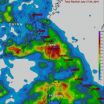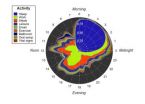(Press-News.org) (Lebanon, NH, 7/25/14) — Researchers at Dartmouth-Hitchcock Norris Cotton Cancer Center are exploring ways to wake up the immune system so it recognizes and attacks invading cancer cells. Tumors protect themselves by tricking the immune system into accepting everything as normal, even while cancer cells are dividing and spreading.
One pioneering approach, discussed in a review article published this week in WIREs Nanomedicine and Nanobiotechnology, uses nanoparticles to jumpstart the body's ability to fight tumors. Nanoparticles are too small to imagine. One billion could fit on the head of a pin. This makes them stealthy enough to penetrate cancer cells with therapeutic agents such as antibodies, drugs, vaccine type viruses, or even metallic particles. Though small, nanoparticles can pack large payloads of a variety of agents that have different effects that activate and strengthen the body's immune system response against tumors.
There is an expanding array of nanoparticle types being developed and tested for cancer therapy. They are primarily being used to package and deliver the current generation of cancer cell killing drugs and progress is being made in that effort.
" Our lab's approach differs from most in that we use nanoparticles to stimulate the immune system to attack tumors and there are a variety of potential ways that can be done," said Steve Fiering, PhD, Norris Cotton Cancer Center researcher and professor of Microbiology and Immunology, and of Genetics at the Geisel School of Medicine at Dartmouth. "Perhaps the most exciting potential of nanoparticles is that although very small, they can combine multiple therapeutic agents."
The immune therapy methods limit a tumor's ability to trick the immune system. It helps it to recognize the threat and equip it to effectively attack the tumor with more "soldier" cells. These approaches are still early in development in the laboratory or clinical trials.
"Now that efforts to stimulate anti-tumor immune responses are moving from the lab to the clinic, the potential for nanoparticles to be utilized to improve an immune-based therapy approach is attracting a lot of attention from both scientists and clinicians. And clinical usage does not appear too distant," said Fiering.
Fiering is testing the use of heat in combination with nanoparticles. An inactive metallic nanoparticle containing iron, silver, or gold is absorbed by a cancer cell. Then the nanoparticle is activated using magnetic energy, infrared light, or radio waves. The interaction creates heat that kills cancer cells. The heat, when precisely applied, can prompt the immune system to kill cancer cells that have not been heated. The key to this approach is minimizing healthy tissue damage while maximizing cancerous tumor destruction of the sort that improves recognition of the tumor by the immune system.
Fiering cautions that there is a great deal of research and many technical variables that should be explored to find the most effective ways to use nanoparticles to heat tumors and stimulate anti-tumor immunity.
According to Fiering, this approach is far from new, "The use of heat to treat cancer was first recorded by ancient Egyptians. But has reemerged with high tech modern systems as a contributor to the new paradigm of fighting cancer with the patients' own immune system."
INFORMATION:
About Norris Cotton Cancer Center at Dartmouth-Hitchcock
Norris Cotton Cancer Center combines advanced cancer research at Dartmouth and the Geisel School of Medicine with patient-centered cancer care provided at Dartmouth-Hitchcock Medical Center, at Dartmouth-Hitchcock regional locations in Manchester, Nashua, and Keene, NH, and St. Johnsbury, VT, and at 12 partner hospitals throughout New Hampshire and Vermont. It is one of 41 centers nationwide to earn the National Cancer Institute's "Comprehensive Cancer Center" designation. Learn more about Norris Cotton Cancer Center research, programs, and clinical trials online at cancer.dartmouth.edu.
Scientists test nanoparticle 'alarm clock' to awaken immune systems put to sleep by cancer
2014-07-25
ELSE PRESS RELEASES FROM THIS DATE:
Clearing cells to prevent cervical cancer
2014-07-25
Boston, MA – A study published online in the International Journal of Cancer earlier this month describes a novel approach to preventing cervical cancer based on findings showing successful reduction in the risk of cervical cancer after removal of a discrete population of cells in the cervix.
The findings come from a study that looked at squamocolumnar junction cells, or SCJ cells. These cells reside in the cervical canal and have been implicated as the origins of cervical cancer. A research team co-led by Christopher Crum, MD, director, Brigham and Women's Hospital ...
Manipulating key protein in the brain holds potential against obesity and diabetes
2014-07-25
DALLAS -- A protein that controls when genes are switched on or off plays a key role in specific areas of the brain to regulate metabolism, UT Southwestern Medical Center researchers have found.
The research potentially could lead to new therapies to treat obesity and diabetes, since the transcription factor involved – spliced X-box binding protein 1 (Xbp1s) – appears to influence the body's sensitivity to insulin and leptin signaling. Insulin and leptin are hormones central to the body's regulation of food intake and sugar disposal, and obesity and diabetes are conditions ...
Why do men prefer nice women?: Responsiveness and desire
2014-07-25
People's emotional reactions and desires in initial romantic encounters determine the fate of a potential relationship. Responsiveness may be one of those initial "sparks" necessary to fuel sexual desire and land a second date. However, it may not be a desirable trait for both men and women on a first date. Does responsiveness increase sexual desire in the other person? Do men perceive responsive women as more attractive, and does the same hold true for women's perceptions of men? A study published in Personality and Social Psychology Bulletin seeks to answer those questions. ...
ACR statement on cancer study regarding patient anxiety from CT lung cancer screening
2014-07-25
Anxiety regarding inconclusive cancer screening test results among some patients is real and is only natural. However, as evidenced by Gareen et al, published July 25 in Cancer, the incidence and effects of anxiety associated with false positive or other results of computed tomography (CT) lung cancer screening exams are far less than claimed by some in the medical community.
"Unsubstantiated claims of systemic and harmful patient anxiety should now be put to rest and not continue to delay implementation of CT lung cancer screening programs or Medicare coverage for these ...
Vanderbilt study examines bacteria's ability to fight obesity
2014-07-25
A probiotic that prevents obesity could be on the horizon. Bacteria that produce a therapeutic compound in the gut inhibit weight gain, insulin resistance and other adverse effects of a high-fat diet in mice, Vanderbilt University investigators have discovered.
"Of course it's hard to speculate from mouse to human," said senior investigator Sean Davies, Ph.D., assistant professor of Pharmacology. "But essentially, we've prevented most of the negative consequences of obesity in mice, even though they're eating a high-fat diet."
Regulatory issues must be addressed before ...
NSU researcher part of team studying ways to better predict intensity of hurricanes
2014-07-25
FORT LAUDERDALE-DAVIE, Fla. – They are something we take very seriously in Florida – hurricanes. The names roll off the tongue like a list of villains – Andrew, Charlie, Frances and Wilma.
In the past 25 years or so, experts have gradually been improving prediction of the course a storm may take. This is thanks to tremendous advancements in computer and satellite technology. While we still have the "cone of uncertainty" we've become familiar with watching television weather reports, today's models are more accurate than they used to be.
The one area, however, where ...
NASA maps Typhoon Matmo's Taiwan deluge
2014-07-25
When Typhoon Matmo crossed over the island nation of Taiwan it left tremendous amounts of rainfall in its wake. NASA used data from the TRMM satellite to calculate just how much rain fell over the nation.
The Tropical Rainfall Measuring Mission or TRMM satellite orbits the Earth and provides coverage over the tropics. TRMM is a satellite that is managed by both NASA and the Japan Aerospace Exploration Agency (JAXA) that acts as a "flying rain gauge in space," that can estimate how fast rain is falling within storms on Earth and how much rain has fallen.
On July 22, ...
Shift work linked to heightened risk of type 2 diabetes
2014-07-25
Shift work is linked to a heightened risk of developing type 2 diabetes, with the risk seemingly greatest among men and those working rotating shift patterns, indicates an analysis of the available evidence published online in Occupational & Environmental Medicine.
Previous research has suggested links between working shifts and a heightened risk of various health problems, including digestive disorders, certain cancers, and cardiovascular disease. But whether diabetes can be added to the list has not been clear.
The authors therefore trawled through scientific research ...
Smartphone experiment tracks whether our life story is written in our gut bacteria
2014-07-25
Life events such as visiting another country or contracting a disease cause a significant shift in the make-up of the gut microbiota – the community of bacteria living in the digestive system, according to research published in the open access journal Genome Biology.
Two participants used smartphone apps to collect information every day for a year in the study by scientists from MIT and Harvard. The authors think the method could be rolled out to studies of human-bacteria relationships with many more participants.
Our microbiota is the community of bacteria that share ...
Leaf-mining insects destroyed with the dinosaurs, others quickly appeared
2014-07-25
After the asteroid impact at the end of the Cretaceous period that triggered the dinosaurs' extinction and ushered in the Paleocene, leaf-mining insects in the western United States completely disappeared. Only a million years later, at Mexican Hat, in southeastern Montana, fossil leaves show diverse leaf-mining traces from new insects that were not present during the Cretaceous, according to paleontologists.
"Our results indicate both that leaf-mining diversity at Mexican Hat is even higher than previously recognized, and equally importantly, that none of the Mexican ...


